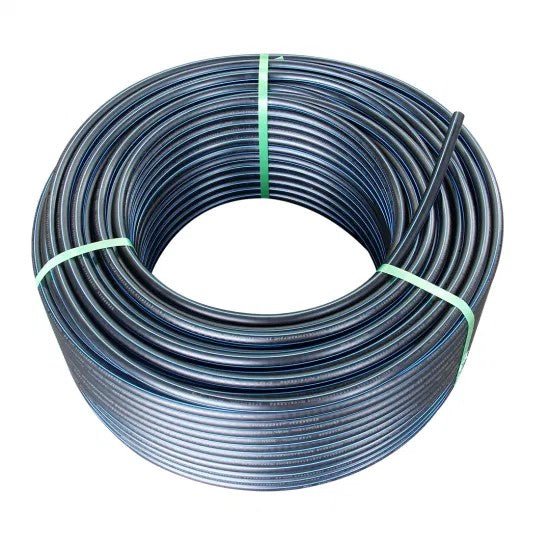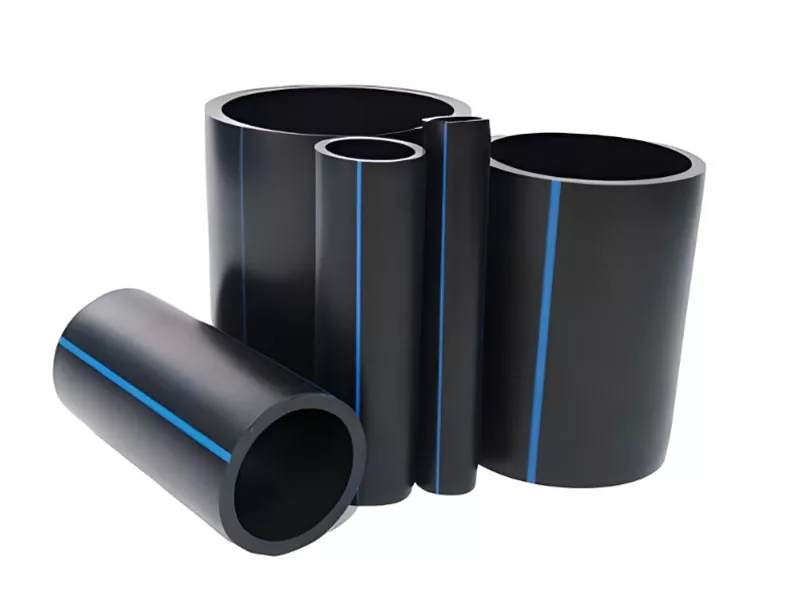How American Plastics HDPE Pipe Manufacturing Maintains Sustainability
Wiki Article
Discover the Production Process Behind High-Quality HDPE Pipeline and Its Applications
The manufacturing process of high-grade HDPE pipelines is complex and methodical. It starts with the option of raw products that boost efficiency. Following this, ethylene undertakes polymerization to form material, which is after that formed with extrusion. Quality control is vital, making sure that the end product satisfies rigid criteria. The journey of HDPE pipelines does not end with manufacturing. Their applications throughout numerous industries expose a more comprehensive relevance worth analyzing.Understanding HDPE: Features and Advantages

High-density polyethylene (HDPE) is a functional thermoplastic known for its longevity and resistance to numerous ecological factors. This product shows excellent tensile strength, making it ideal for requiring applications. Its low-density structure adds to a light-weight item, assisting in convenience of handling and installment. HDPE likewise showcases impressive resistance to chemicals, which reduces destruction when subjected to rough compounds.
The product's low dampness absorption additionally enhances its long life, making it excellent for usage in pipelines and storage space containers. Furthermore, HDPE is immune to ultraviolet (UV) radiation, making certain that products maintain their stability even when subjected to sunshine. Its flexibility permits for the creation of detailed shapes without jeopardizing toughness. The green nature of HDPE, often stemmed from recycled products, includes in its appeal, advertising sustainable practices in production. Generally, these properties and benefits make HDPE a favored choice for various commercial and customer applications.
Basic Material Selection for HDPE Manufacturing
The choice of resources for HDPE production is necessary to verify the end product fulfills the wanted specifications and high quality requirements. High-density polyethylene (HDPE) is mainly generated from polymerized ethylene, originated from fossil gas such as gas or petroleum. The high quality of these feedstocks substantially influences the mechanical and thermal properties of the last HDPE.Additives additionally play a considerable role in enhancing HDPE's performance, consisting of anti-oxidants, UV stabilizers, and colorants, which improve longevity and resistance to environmental aspects. The selection process should think about not only the chemical composition of the raw products however additionally their handling characteristics to ensure effective production.
Moreover, the sourcing of basic materials should prioritize sustainability and compliance with environmental regulations, as responsible methods are imperative in today's market. Eventually, careful raw product option lays the structure for producing high-quality HDPE pipes ideal for diverse applications.
The Extrusion Refine: Forming HDPE Pipeline
The extrusion process plays a crucial function in shaping HDPE pipelines, beginning with precise product preparation techniques that assure optimal flow and uniformity. Similarly essential is the design of the die, which directly affects the final dimensions and surface top quality of the pipe. Together, these aspects add substantially to the effectiveness and top quality of HDPE pipe manufacturing.Product Prep Work Techniques
Efficient manufacturing of HDPE pipes begins with precise material prep work strategies, especially the extrusion process. During this phase, high-density polyethylene resin is first dried out to remove wetness, making sure ideal circulation features. The resin is then fed into the extruder, where it undertakes heating and melting, transforming into a thick state. This home heating process is carefully regulated to maintain the product's integrity and performance. The liquified HDPE is compelled via a die, shaping it right into a continual pipeline form. Proper temperature management throughout extrusion is necessary, as it directly influences the product's residential or commercial properties and the end product quality. When formed, the HDPE pipeline is cooled and cut to specified sizes, all set for subsequent handling and applications.Die Layout Value
Precision in die design plays a vital duty in the extrusion procedure of HDPE pipelines. The die acts as the final shaping tool, straight affecting the pipeline's dimensions, wall surface density, and surface finish. A well-designed die warranties consistent material circulation, decreasing issues such as abnormalities and weak places. The geometry of the die have to be maximized to suit the certain residential or commercial properties of HDPE, including its viscosity and thermal habits during extrusion. Additionally, the cooling price of the material as it goes through the die can noticeably affect the pipeline's architectural stability. Spending in advanced die innovation is crucial for manufacturers aiming to create premium HDPE pipes that satisfy sector requirements and client assumptions.Quality Assurance Procedures in HDPE Production
Different variables influence the top quality of HDPE pipeline manufacturing, effective quality control procedures are essential to guarantee uniformity and dependability in the last product (American Plastics HDPE Pipe for Oilfield). Trick quality assurance techniques include extensive material assessment, verifying that the raw polyethylene fulfills established requirements for pureness and thickness. Throughout the extrusion process, criteria such as temperature, stress, and cooling time are carefully monitored to preserve dimensional precision and architectural stabilityOn top of that, post-production testing is essential; suppliers often perform hydrostatic examinations to analyze the pipeline's strength and resistance to stress. Aesthetic examinations for surface area defects better improve quality control. Accreditation from relevant standards companies, like ASTM or ISO, gives an extra layer of credibility. By implementing these complete quality assurance measures, suppliers can lessen issues, boost performance, and make certain that the HDPE pipelines meet the certain demands of numerous applications, eventually causing customer complete satisfaction and rely on the item.
Applications of HDPE Pipe Across Industries
HDPE pipes are utilized across different markets as a result of their durability and adaptability. In water distribution systems, they assure efficient shipment, while in wastewater administration, they provide trusted services for waste transportation. Furthermore, agricultural irrigation networks take advantage of HDPE's resistance to corrosion and adaptability, making it a suitable choice for modern farming methods.
Water Circulation Equipments
A considerable number of industries depend on high-density polyethylene (HDPE) pipelines for reliable water circulation systems. check these guys out Understood for their sturdiness and resistance to corrosion, HDPE pipelines are widely utilized in metropolitan water supply networks, farming watering, and industrial applications. Their lightweight nature facilitates easy handling and installation, minimizing labor costs and time. Furthermore, HDPE pipelines can suit different stress levels, making them ideal for both low and high-pressure systems. hdpe pipe suppliers Midland TX. The adaptability of the material enables seamless integration into existing infrastructure, decreasing the requirement for comprehensive excavation. In addition, HDPE's resistance to chemical leaching guarantees that the water provided continues to be safe and tidy, making it an optimal selection for keeping the quality of potable water across various fieldsWastewater Administration Solutions
Reliable water distribution systems additionally lead the way for cutting-edge wastewater monitoring options, where high-density polyethylene (HDPE) pipes play a significant role. Distinguished for their durability and resistance to rust, HDPE pipes are excellent for delivering wastewater in various settings. Their versatility permits very easy setup in complex settings, decreasing the requirement for extensive excavation. Additionally, HDPE's smooth indoor surface minimizes friction, boosting circulation rates and effectiveness. These pipelines are likewise immune to chemical leaching, ensuring that impurities do not compromise the surrounding environment. Industries, towns, and treatment facilities progressively depend on HDPE pipelines for their dependability and longevity, making them a favored choice for modern wastewater management systems. This flexibility emphasizes the essential relevance of HDPE pipelines across many applications.Agricultural Irrigation Networks
Agricultural irrigation networks benefit significantly from the use of high-density polyethylene (HDPE) pipelines, which give efficient and reputable water delivery to crops. HDPE pipelines are light-weight, making them easy to transfer and set up, while their versatility permits for various arrangements in diverse surfaces. These pipes demonstrate exceptional resistance to rust, chemicals, and UV radiation, guaranteeing longevity in harsh farming atmospheres. Additionally, their smooth interior surface lessens friction loss, optimizing water circulation and minimizing energy costs related to pumping. The long life of HDPE pipes, frequently exceeding half a century, adds to reduce upkeep and replacement expenses. Consequently, farmers progressively rely upon HDPE pipelines to improve watering efficiency and promote lasting agricultural practices, ultimately bring about improved plant returns and source preservation.pop over to this web-site
Future Patterns in HDPE Pipeline Technology
As the demand for lasting and effective facilities expands, developments in HDPE pipeline innovation are poised to change various markets. Arising fads consist of the integration of clever technologies, such as sensors and IoT abilities, which facilitate real-time tracking of pipeline problems, reducing upkeep costs and avoiding leakages. Furthermore, the advancement of advanced manufacturing methods, such as 3D printing, is making it possible for the production of complex, customized pipe styles that accommodate details job needs.The focus on recycling and circular economy techniques is rodding sewer line driving the advancement of HDPE pipelines made from recycled products, enhancing sustainability. Boosted jointing techniques, such as electro-fusion and mechanical installations, are additionally boosting installation effectiveness and integrity. Ultimately, the expanding emphasis on environmental policies is pressing suppliers to embrace greener production procedures, ensuring that HDPE pipes not only fulfill market requirements yet likewise promote an even more sustainable future for infrastructure growth.
Regularly Asked Questions
How Does HDPE Contrast to Various Other Plastic Products?
HDPE outperforms several various other plastic products relating to sturdiness, chemical resistance, and adaptability. Its low thickness and high tensile strength make it optimal for various applications, usually exceeding options in both efficiency and durability.What Are the Environmental Effects of HDPE Production?
The environmental impacts of HDPE production include greenhouse gas discharges, power intake, and prospective contamination from producing processes. Furthermore, inappropriate disposal can cause dirt and water contamination, raising worries regarding long-lasting ecological results.Can HDPE Pipeline Be Recycled?
Yes, HDPE pipes can be recycled. Numerous facilities accept used HDPE for handling, transforming it right into brand-new products. This reusing adds to sustainability initiatives, decreasing plastic waste while preserving sources and energy in the manufacturing cycle.What Is the Life Expectancy of HDPE Pipes?

How Do Temperature Level Variants Impact HDPE Pipe Performance?
Temperature variants significantly affect HDPE pipeline efficiency, influencing versatility and stamina. Heats can bring about softening, while reduced temperatures may trigger brittleness, ultimately influencing the pipe's sturdiness and viability for various applications in varied atmospheres.Report this wiki page